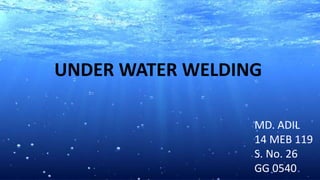
UNDER WATER WELDING
- 1. UNDER WATER WELDING MD. ADIL 14 MEB 119 S. No. 26 GG 0540
- 2. Outlines.. • Introduction and history • Importance of underwater welding • Principle of operation • Classification • Advantages and Disadvantages • Risks involved and Safety • Applications • future Scope • Conclusion • Refrences 2
- 3. Introduction and History.. Process of welding underwater or elevated pressures Khrenov , a Russian engineer, In 1932 invented the under- water welding. In 1946,First water proof electrode made in Holland by Van der Willingen 3
- 4. Importance of Underwater welding 4
- 5. Principle of operation.. 5 Arc is an electric current flowing between two electrodes through an ionized column of gas.
- 7. Classification.. Broadly divided into two types Dry welding Wet welding 7
- 8. Dry welding water is sucked out Cabin is made 8
- 9. Wet welding 9 Job is performed directly in water
- 10. Advantages of wet welding No enclosure or cabin is required. Easily reachable to any type of portion. Minimum amount of equipment is required. High operating speed. 10
- 11. Disadvantages of wet welding Rapid quenching reduces impact strength and ductility. Poor visibility due to contamination of water. Hydrogen embrittlement cracks. 11
- 12. Advantages of dry welding Better safety of diver. Good quality of welds. No fear of shock for welder. 12
- 13. Disadvantages of dry welding Higher cost of training and process. It cannot approach to unreachable place. Large quantity of heavy and costly equipments. 13
- 14. Risks involved Chances of electric shock. Possibility of an explosion. Decompression sickness. 14
- 15. Continued.. Danger of “ delta p” pressure . 15
- 16. Safety measures.. Proper training Proper insulated suit for welder. Avoid formation of gas bubbles to avoid explosion. 16
- 17. Applications. Repairing of pipelines. Oil is being extracted from a large depth in the sea. 17 Welding of pipeline
- 18. Continued.. 18 Repairing of ships Maintainance of naval objects.
- 19. Live video of underwater(wet) welding. 19
- 20. Future scopes.. Development of alternate methods like friction welding ,explosion welding etc. Proceeding towards the automation of underwater welding. 20 Friction welding
- 21. Conclusion.. • Underwater welding is a very advanced technique. It helps up a lot in our activities. • But still it is needed Improvement to avoid accidents and explosion . 21
- 22. Refrences www.slideshare.net www.weldpedia.com www.wikihow.com/Weld-Underwater www.banglajol.info/index.php/JNAME/article/view/927/993 www.google.com/search 22
- 23. THANK YOU